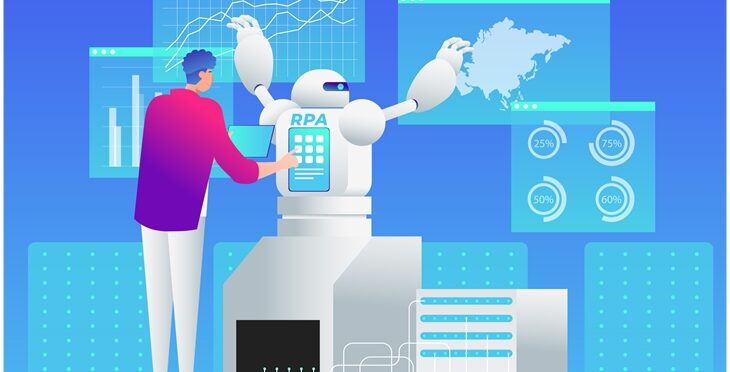Use Cases Of RPA In Supply Chain aim to automate manual procedures. It leaves less possibility for errors and abnormalities. RPA tools are software solutions that run on virtual servers and can start and stop at any time.
RPA is still in its infancy in supply chain operations. Still, many firms have up their efforts to incorporate automation into their supply chains to make them lean and efficient. Companies in industries such as healthcare, retail, and manufacturing have relied on tech such as RFID, ERP, CRM, etc.
Initially, software robots were not adaptable to deal with the scenarios that arose. They were not smart and could only automate a part of the supply chain. Manual intervention was required for everything else. Today, intelligent bots are incorporated with ML and cognitive capabilities. It has also resulted in RPA systems that resemble humans to some extent.
We are working toward automating tasks defined by business rules with these technologies. Also, these are laying the groundwork for processing inputs. RPA in Supply Chain can also help to forecast outcomes and assist with decision making. It can also assist employees with jobs other than robotics. Here are a few sectors of the use cases of RPA in supply chain that are ready to change, thanks to RPA.
- Use Cases of RPA in Supply Chain
- Order Processing and Payments
- Effective Vendor Selection
- Finalization of the Vendor
- Procurement Risk Reduction Through Automation
- Automation of Inventory Management
- Automation of Emails
- Management of Transportation and Logistics
- Planning for Supply and Demand
- Onboarding of Partners
- Making a Sales Order
- Relationship Management and Customer Service
- List Of Best RPA Tools
Use Cases of RPA in Supply Chain
Order Processing and Payments
Order processing is a component of the supply chain. It comprises manufacturers, distributors, and retailers, as well as the following phases:
- Product choice
- Manual entry of customer information
- Processing of payments
- Order updates and confirmation
Relying on paper documents and physical labor to process these transactions also risks inaccuracy. It also causes unnecessary time consumption. In the supply chain, RPA may automate various back-office processes. This also reduces the need for manual labor.
Effective Vendor Selection
Vendor selection is a time-consuming task in SCM. This is because it involves many manual processes such as:
- Request planning
- Interaction with vendors
- Verification of the vendor's documents
- Evaluation of vendor credits
Finalization of the Vendor
Your autonomous bot can assess credit value. It can even finish vendor selection based on established criteria using RPA.
Procurement Risk Reduction Through Automation
In managing and expanding the supply chain network, the company faces many procurement risks. It is critical to alter supplier relationships to reduce risks. This improves product mix and reduces procurement costs. The modifications can go with mechanisms such as:
- Monitoring the performance of current suppliers
- Choosing new suppliers
- Contract negotiations
Manual procedures like form filling, documentation, and emailing are there in these processes. RPA also strives to reduce effort. It does so by automating these manual operations and making rules-based judgments.
Automation of Inventory Management
You should be mindful of your inventory levels. It helps to ensure that you have adequate products and spares to meet the demands of the business. RPA in supply chain management can also automate inventory management. Moreover, it can alert you when stock levels are low. In the best scenario, bots can reorder things that fall below a certain threshold level. Also, supply chain automation can take account of previous data & predict inventory levels.
Automation of Emails
It is critical to maintain good communication. There should be a clear dialogue between customers, transportation service providers, suppliers, and manufacturers. This also maximizes supply chain management. You should also maintain open communication to establish trust and credibility in situations such as:
- Delayed shipment.
- Obstacles in order fulfillment
- Orders received, processed, and dispatched.
Using RPA to manage the supply chain can automate this communication. It can also send an email to the recipients when their order gets processed, delayed, or shipped.
Management of Transportation and Logistics
Logistics is an essential component of SCM. Logistics plans execute and manage the movement and storage of products and services. This is necessary to meet the needs of customers. Shipping scheduling and tracking in logistics need various human laborers. This is to interact with many labels, websites, programs, and so on. RPA can also automate invoices and proof of delivery operations. It can enable real-time precise shipment tracking, which helps with planning.
Planning for Supply and Demand
Another operation worthy of automation in SCM with RPA bots is supply and demand planning. This process requires data from multiple sources to make judgments. These sources can be such as sales target, sales history, seasonal changes, price trends, current inventory levels, product roadmaps, shipments expected, etc.
RPA helps organizations manage demand and supply planning. It can also function across many operations such as procurement, warehouse, inventory, and shipping. Moreover, the RPA bot predicts demand and notifies the procurement team using AI and ML.
Onboarding of Partners
Setting up contact with a partner needs the processing of contracts and government paperwork. It also needs the verification of your initial requirements and the maintenance of a record of each document. Also, different partners use distinct data translation formats and business rules.
RPA bots can complete all these stages in a fraction of the time that it would take human workers to complete. By providing an automated approval mechanism, bots can increase efficiency.
Making a Sales Order
When you receive buy orders via email, you must create corresponding sales orders. You can use bots to conduct these repetitive operations to save time and reduce the chance of errors. Instead of spending days compiling reports, you can automate real-time report compilation and sales-performance analyses.
Relationship Management and Customer Service
Organizations use various distinct systems for business processes. This causes customer information to update in different systems. This needs synchronization to enable good customer care. Also, in the supply chain process, the system demands that clients' ordering privileges be suspended until the account manager gets notified.
RPA can automate these manual processes that span various information systems. This type of automation also assists businesses. It also ensures that customer care can focus on quality tasks to build the client connection.
List Of Best RPA Tools
Eggplant from Keysight
RPA Solution provided by Keysight's Eggplant Software automates the execution of repetitive processes. It also boosts productivity while decreasing errors. Eggplant also contains a universal fusion engine. Moreover, this allows it to test any system, from mobile to mainframe. It can run on Windows, Mac, and Linux. Eggplant also offers end-to-end automation. It can also communicate with multiple systems to complete the work.
Features:
- Eggplant includes data-driven automation features. These features also allow for connecting data sources and executing a job for each record.
- Eggplant Functional is capable of automating both front-office and back-office applications.
- Eggplant DAT includes functionality for dealing with any data store. It can also scrape data right from the screen.
- It provides extensive verification and validation functionalities that confirm process operation.
Rapise Inflectra
Rapise by Inflectra is a test automation system. It specializes in testing complicated applications like Microsoft Dynamics, Salesforce, and SAP. Rapise is now in its seventh iteration. It supports hybrid business settings. It can also automate desktop and mobile applications.
Rapise allows testers and engineers to connect to the user interface of the apps under test. It can also simulate user activities to perform business tasks. Rapise is easy to use for both programmers and non-programmers. It's also accessible as an on-premise option.
Features:
- Analog and synthetic job recording and playback are included in the built-in record and play capability.
- Web and desktop automation, as well as web and screen scraping
- Rapise Visual Language (RVL) is a one-of-a-kind code-free system. It helps to record and maintain automation processes.
- REST and SOAP calls, as well as email processing (Gmail, Office 365, private mail servers).
- Allows for open platform improvements and integration.
Blue Prism
Blue Prism provides all core capabilities. It is compatible with any platform and application. It requires programming expertise to use. Still, it is user-friendly for developers. Moreover, this product is mainly useful for medium and large businesses.
Features:
- It enables a multi-environment deployment model.
- Security for network and software credentials.
- It can function on any platform.
- Can function for any application.
UiPath
UiPath has all the essential features. It includes Citrix support. UiPath is also user-friendly for non-developers. It is capable of handling complex processes. This tech is also appropriate for any size of business.
Features:
- It provides security by managing credentials data, limiting access depending on the role.
- It can automate very fast. Citrix can also provide eight to ten times faster automation.
- It serves as an open platform.
- It can handle any process, in any number, regardless of how sophisticated it is.
Anywhere Automation
Automation Anywhere includes all the essential features. It offers both on-premise and cloud-based services. This user-friendly solution is ideal for medium and big businesses.
Features:
- Offers bank-grade security.
- Authentication, encryption, and credentials provide security.
- Reports and analytics in real-time.
- Allows for platform independence.
Pega
It is suitable for use on desktop servers. Pega solely offers cloud-based solutions or services. It is compatible with Windows, Linux, and Mac. Pega is most ideal for medium to large-sized businesses.
Features:
- It will aid you in the implementation of your solutions to consumers
- Pega offers a solution that is cloud-based.
- It does not store any data in a database. Instead, it stores everything in memory.
- This tool can distribute tasks to desktops, servers, and staff.
Contextor
This gadget is ideal for any size front desk. It offers both on-premise and cloud-based services. Contextor includes Citrix support. It is applicable to all workstation programs. Contextor can communicate with both active and minimized programs.
Features:
- It is capable of communicating with all workstation apps at the same time.
- Contextor is compatible with Citrix and RDP hybrid virtualization environments.
- It delivers statistics and reporting.
Conclusion
RPA software can be a useful tool for automating a company's most time-consuming activities and saving employees time. But, it is not without hazards. Still, most businesses gain far more value from process automation than they risk. It is also critical to understand the dangers of using RPA and to make clear and reasonable expectations for your company's leadership and execution teams. Use Cases Of RPA in Supply Chain project that businesses will be far more likely to enjoy the amazing benefits that RPA has to offer.
You may also like to read:
5 Use Cases of RPA in Financial Services
10 Best Practices for RPA Change Management





